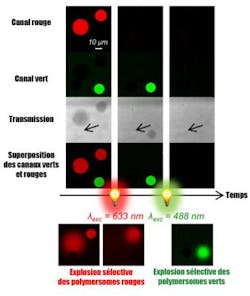Laser irradiation produces vesicle explosions to mimic cellular reactions
A team of researchers from the Centre National De La Recherche Scientifique (CNRS; Paris, France) and the Polytechnic Institute of Bordeaux (Bordeaux INP; Talence, France) used laser irradiation to control the explosion of polymersomes. These hollow polymer spheres, which can mimic certain cellular functions, react to a specific wavelength and thus release their content on demand.
Polymersomes are artificial vesicles that can mimic organelles—compartments naturally found in nucleic cells. The research team encapsulated fluorescent molecules in "giant" polymersomes with a 12 µm diameter. These fluorescent groups have the characteristic of decomposing under the action of light, but only at a specific wavelength. A suitable level of irradiation degrades these molecules and thus increases the solute concentration within the polymersomes. This entails an imbalance that, because the polymersomes are relatively impermeable, cannot be compensated with sufficient speed. The vesicles are thus forced to rupture.
The team designed three types of polymersomes, each containing a specific fluorescent group, meant to react to different wavelengths. Doing so, the researchers could reach a level of control that enabled them to observe the vesicles and target them individually using a confocal microscope equipped with adequate lasers. In addition to light, other methods of control are currently being developed by researchers to rupture microvesicles: temperature, pH, magnetic fields, and so on.
The work could have medical applications in the long term, but for the time being the researchers are studying the possibility of releasing substances in a controlled manner within artificial polymer cells to be able to reproduce and better understand some of the metabolic reactions of the biological cell.
Full details of the work appear in the journal Angewandte Chemie International Edition; for more information, please visit http://dx.doi.org/10.1002/ange.201609231.

